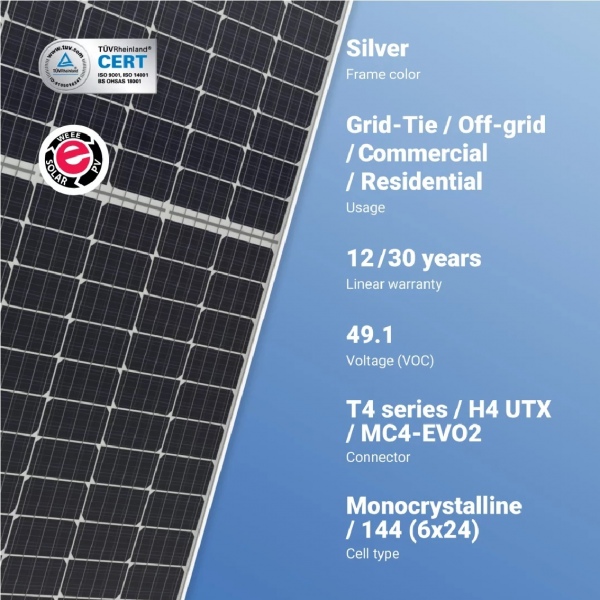If you’re seriously considering busting your electricity bills by harvesting the sun’s energy from your rooftop, there are 2 main decisions you need to make when choosing a solar power system.
1) What configuration of solar panel system do you require?
You can choose from:
a) Grid Connect Systems
![]()
98% of solar systems sold in Australia are connected to the grid. The main reason being that they are the most reliable and cheapest way to add solar power to your home. Why? Because the grid acts like a giant battery with an almost infinite capacity to both provide power when you need it and to absorb excess electricity when your panels are producing more energy than your home can use. This means you don’t have to buy expensive battery systems or any fancy controllers to charge and discharge them. Most of the info on this site is related to grid connect solar power systems.
b) Off Grid Systems
![]()
These are expensive. You generally only go for off grid solar power if you are in one of 2 situations:
i) you live in the sticks and have no local grid connection.
ii) You have access to the grid, but you hate the thought of depending on it so much that you are happy to spend tens of thousands of dollars extra for an off grid system.
If you suspect that off grid solar power is what you need then you may enjoy my guide to Off Grid Solar Systems.
c) Hybrid Systems
![]()
The “third way” which is kind of a mash up of on-grid and off-grid technologies is often called a hybrid solar power system. It is essentially a grid-connected solar power system with battery storage. It is a lot more flexible than a grid connect system, but cheaper than an off grid system.
Hybrid solar systems can be an elegant way to beat stingy feed in tariffs now operating in most Australian states where you may get as little as 8c per kilowatt-hour for the electricity you export, and have to pay more than 30c to buy it back later.
If you’d like to know how you can use hybrid systems to maximise the value of your solar electricity, and stick it to the greedy power companies, then I’ve written about hybrid solar systems here (including how much they cost).
2) What
size solar system do you need?
Once you’ve decided on the configuration, the next most important consideration is what size solar power system do you need.
Here are the most common system sizes on the market. The following solar system sizes probably account for at least 90% of those sold in Australia:
Used to be popular – now too small to bother with: The 1.5kW Solar System (6 x 250W panels)
This size makes up a significant chunk of all systems that have ever been sold in Australia. Why? Because the pre-2013 solar rebate maxed out at 1.5kW. This means that for the previous 4 years a 1.5kW solar PV array gave you the most kW per dollar spent. Since the solar power rebate changed on Jan 1 2013, the rebate does not favour 1.5kW systems anymore. You get the same rebate for every kW bought. And that’s a good thing. Because, unless you have a super energy-efficient home, a 1.5kW system isn’t going to make much of a dent in your electricity bill. Current pricing for a good 1.5kW setup is about $2,400 – $3,400 after rebates. But you’ll struggle to find an installer that sells such small systems these days.
These days the smallest system you can easily buy is a 3kW solar power system (approx 9 x 330W panels). This will usually offset three-quarters of an average Aussie homes’ electricity usage and cost about $4,000 – $4,500. As you can see, there’s very little difference in pricing compared to a 1.5kW system considering the extra capacity you get.
If wiping out your electricity bill is important to you then skip the 5kW solar system and go for at least a 6kW system, actually, 6.6kW – I explain why here.
The next size up in the residential market would be a 10kW solar system; which has a whopping 30 solar panels (at 330W each). This size tends to be popular with large consumers that really want to crank out the green energy!
If you have a 3 phase supply, popular sizes are 15 kW all the way up to 30 kW if you have a roof the size of a football pitch.
So that’s a very quick guide to the two main choices you have to make when buying a solar power system:
1) What type? On Grid / Off Grid / Hybrid
2) What size?
A grid connect system of 6.6 kW will suit most Australian households. Big energy users should consider going even bigger. Deciding that you need grid connect is the easy bit. Choosing the correct size: 6.6 kW or bigger is where it can get tricky. Get it right and you have a great investment and almost no power bills. I get emails from people every day that have got the right advice and are ecstatic at not having electricity bills anymore.
Get the size wrong and you suffer one of two ways. You either have an array that makes almost no dent in your power bills without a costly solar upgrade, or you pay way too much for too big a system that will take a long time to pay for itself.
A good solar salesperson will only deal in solar power facts and will want to sell you the system size that makes sense for you given your energy requirements and situation. A bad one will simply pluck numbers out of the air and try to get you to go as big as possible to fatten his commission.
A good solar power salesperson will not recommend a system size until it’s been established both how much electricity you use every day and just as critically what times of day you use the electricity. Armed with that information the salesperson should be able give you an accurate estimate of your energy bill reduction and your payback period. And he/she should be prepared to guarantee it in writing!
If you want a quick explanation of why solar system sizing seems more complicated than it should be (and why a good installer who can work it out for you is a wonderful thing), then I go into great detail





















